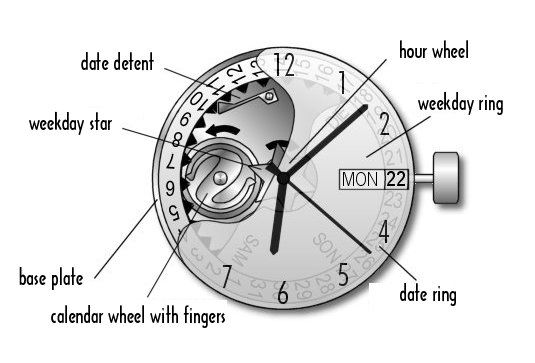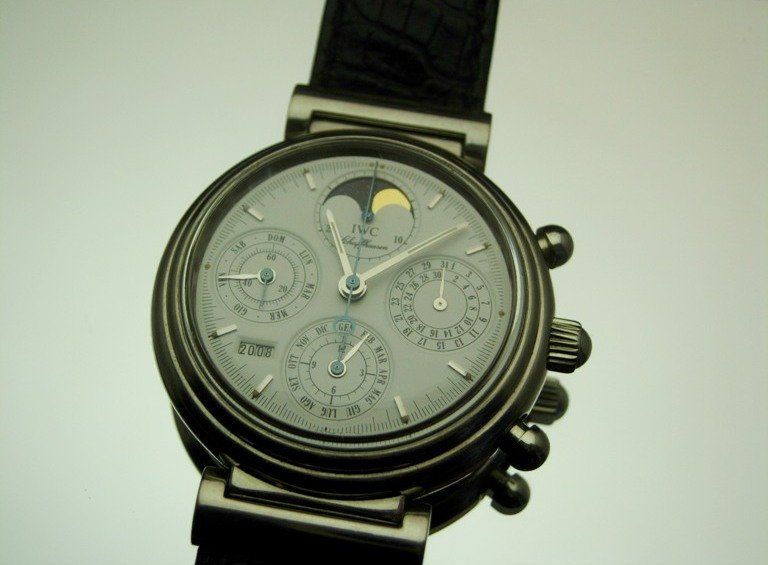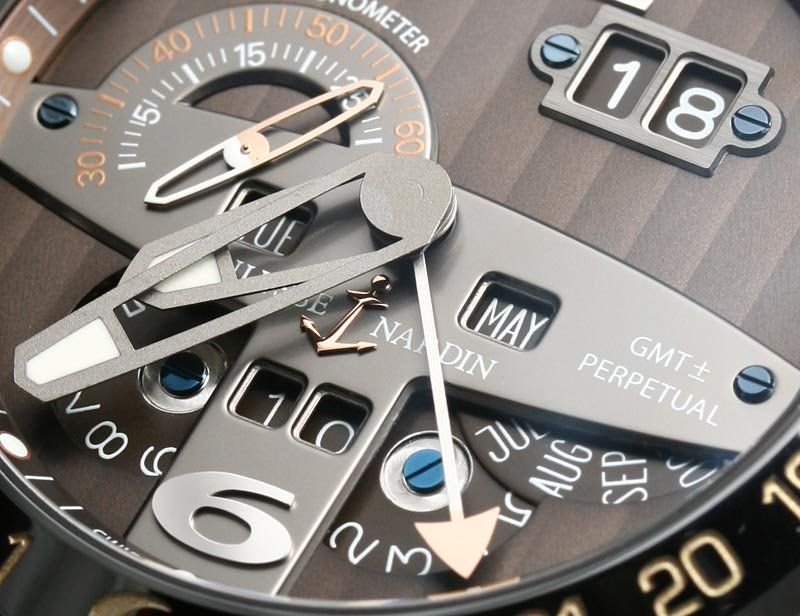
Calendar watches: Differences between simple, full, annual and perpetual calendars
Marcus Hanke


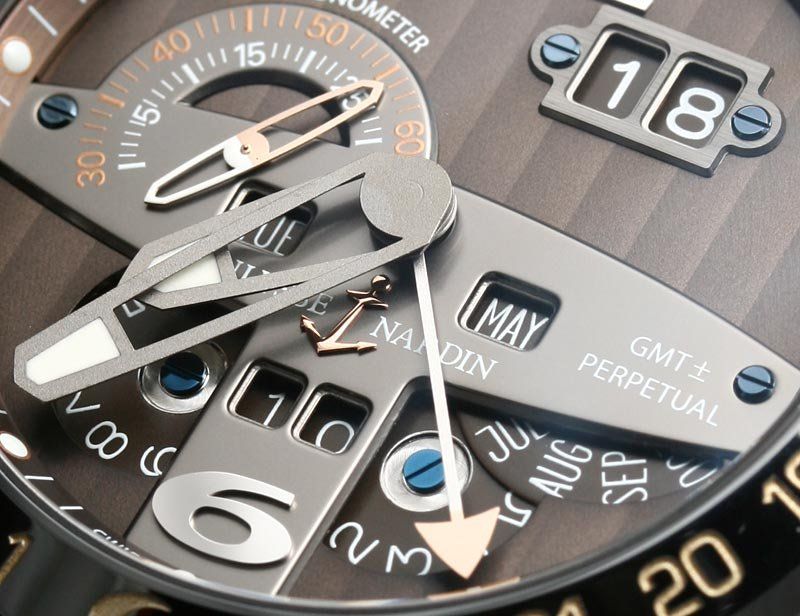
Simple, Full, Annual, Perpetual Calendars - more than just a date
by Marcus Hanke
by Marcus Hanke
On numerous occasions, I am asked about the different calendar mechanisms that are offered in various mechanical watches, and often there are misunderstandings, regarding their function and display. First all, it is important to note that we have to differ between the calendar mechanism located under the dial, and the calendar display on the dial itself. Not necessarily, the dial display reflects the mechanism's true complexity, and vice versa. The dial display can be simple, yet it is driven by a perpetual calendar mechanism, while other dials appear wonderfully complex, making the spectator think that there must be a very fine and complicated mechanism behind it, while in fact it is all but a show, made to impress people and stimulate the purchase decision. The latter is often the case with cheaply made watches, mostly of Chinese origin:

(c) Ingersoll
This watch desperately tries to appear like something it isn't: a perpetual calendar watch. It looks busy, very complicated, with lots of calendar indications. In fact, its Chinese movement has but a very simply day-date mechanism. The rest is mockery: What appears to be a moon phase display, is a simple day-night indicator, coupled with the 24 hours hand. The normal hour wheel drives another wheel with twice as many teeth, so it rotates once per day. That's all. The windows showing the month, and even the year, have no functionality at all. Their displays have to be advanced manually, by means of large pushers. These oversized corrector pushers also have the wanted effect to make unsuspecting spectators believe this watch is a chronograph. While the brand depicted above is a legitimate business, this pusher design is also very popular with counterfeiters of well-known expensive chronographs: instead of real start-stop and reset mechanisms, the pushers only advance date and weekday displays.
On the other hand, this absolutely simple-looking watch houses a real perpetual calendar mechanism:
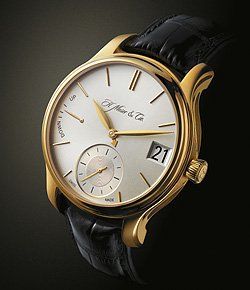
(c) H. Moser & Cie.
As a consequence, we have to avoid the conclusion that "what appears complicated, must be complicated", and concentrate on the calendar mechanisms hidden under the dial. All watch calendar systems are based on the rotation of the hour wheel, that normally needs 12 hours to complete, as it drives the watch's hour hand. Since the calendar changes but once per day, this rotation has to be transformed into one every 24 hours, by adding an intermediary wheel with the double number of teeth as the hour wheel. This 24 hour wheel can be used for several purposes: for a 24 hours hand, a day/night indicator, or you equip this wheel with a finger, that serves to advance a date ring once a day. That would be the
1. "Normal" or monthly calendar: has a date display (either window or hand) from 1 to 31. Changes the date every midnight, but has to be corrected manually in every month with less than 31 days.
1.a. "Day-date": Adds a weekday display to the date, but the mechanism is still the same: at the end of every month with less than 31 days, it has to be corrected.
This weekday indication is also advanced by the 24 hours wheel, that simply received another finger, switching the date and weekday indicators at (roughly) the same time.
1.b. Moon phase: The 24 hours wheel can also be used to advance a moon phase display. Here, the problem lies in the fact that a complete cycle of the moon can not be divided into full 24 hours periods, Consequently, one daily step of the moonphase display will sooner or later result in a divergence between the watch's indication and the real phase of the moon. Please learn more about the moon phase accuracy problem and the watch industry's efforts to solve it by clicking here.
The moon phase display became a popular decorative element on watches, so it is not unusual to find such indications even without any other calendar displays. But much more often, it is combined with a small pointer calendar:
1.c. "Full calendar": Adds a month display, and - sometimes - also a moon phase.
Based on the 24 hours wheel and the date ring, other calendar indications can be realised. A so-called "full" or "complete" calendar features the indications of at least the date, weekday and month, sometimes combined with a moon phase.
A. Nicolet full calendar with moon phase, pointer calendar, weekday and month display

The ETA/Valjoux 7751 became the most popular full calendar movement, combining the latter with a chronograph

The ETA/Valjoux 7751 became the most popular full calendar movement, combining the latter with a chronograph
The mechanism's intelligence is still the same as on the simple calendar watch, but additionally, you have to adjust the correct month and the moon phase. Some movements do switch to the next month whenever the date jumps from 31 to 1 of the next month, but there are also movements where the month display does not have any automatic gear at all, but has to be advanced manually every month.
2. "Annual" calendar: This mechanism derives its name from the fact that it has be manually adjusted by the wearer only once a year. Contrary to the standard watches with date display, these calendars already need some kind of mechanical program: the sequence of months with 31 and 30 (special case February is now treated as 30) days is as following: X - X - X - X X - X - X. The gearing is pre-programmed to show all 31 date numbers in months with X, but to quickly pass over the 31 and immediately switch to 1 from 30 in months with -. Unfortunately, the February is a special case, normally having 28 days, with a 29rd day every four years (leap year). This month is not recognized in the program, so every year, the owner has to manually interfere, by changing from 28th (or 29th) of February to the 1st of March.
When Patek Philippe presented its Ref. 5035 annual calendar in 1997, it stirred quite some attention, since this complication was barely known before:
These annual calendars are still rare, but a highly interesting complication. For correct use, they only need a month display aside the date:

Annual calendar mechanism with big date and small month display, added to the ETA 2894 modular chronograph movement by Dubois-Dépraz
Sometimes, other indications, such as weekday and/or moon phase can be added, but do not affect the classification as "annual calendar".

"MIH Watch" (prototype): Annual calendar with linear display of weekday, month and date, by Ludwig Oechslin and Paul Gerber, based on an ETA/Valjoux 7750 movement

Patek Philippe annual calendar, combined with chronograph
3. "Fouryears calendar": These are really rare, I am aware of only an older Breitling offering this complication. The "program" of the annual calendar is extended her, by recognizing the February as a month with 28 days. As a consequence, the owner needs not to interfere with the mechanism for four years. Only in leap years, he has to manually change the February from 28 to 29.
4. Perpetual calendars: The next step is the extension from recognizing the 28 days February every year to the recognition of the one February with 29 every four years (leap year). Counting the program interval, this means that the watch has a full four years program, that is constantly repeated. Thus, it is not really a "perpetual" calendar, because our Gregorian calendar system will drop a leap year every 100 years. Consequently, nearly all mechanical perpetuals on the market will have to be manually corrected every 100 years.
It is some kind of generally accepted dogma that perpetual calendars are complicated watches and have to look complicated:

Jules Audemars perpetual calendar by Audemars Piguet, with additional displays of sunrise and sunset on a given place, and equation of time
In fact, the mechanism of
the perpetual calendar itself can be realized with relatively small
effort, compared with that necessary to build a good chronograph
movement. Especially, if only hands are used for the calendar
indications, it is not even necessary to add any jeweled bearings, since
the parts do not move quickly. This is an example of such a "simple"
perpetual, where the calendar module makes use of only steel bearings:

Bergter perpetual by Union/Glashütte

Bergter perpetual by Union/Glashütte
Since
common perpetuals are based on a mechanically programmed sequence of
days-per-month during a four years interval, the user only needs an
indication of where within that four years interval his watch currently
is. The watch depicted above employs the simplest solution, by showing
all 48 months of the complete cycle in one subdials, marking the one
year where the February would have 29 instead of 28 days (leap year). Of
course, the legibility of this subdial is rather poor, without reading
glasses it is rather unlikely to recognize the correct month.
Consequently, other mechanisms add a separate indication for the leap
year cycle, like the Audars Piguet above, just aside the hourmarker at
1.
Another possibility is to indicate the civil calendar year itself:

Perpetual GMT by Ulysse Nardin: All calendar indications are shown in separate windows: (big) date, weekday, month and calendar year
Again, the designation as a "perpetual" is based solely on its mechanical program, and not on the number of indications.The number and nature of dial indications is not necessarily connected with the fact that a certain watch is a perpetual calendar. This Moser perpetual, for example, only shows the date and the month, neither weekday, nor moon phase is shown:
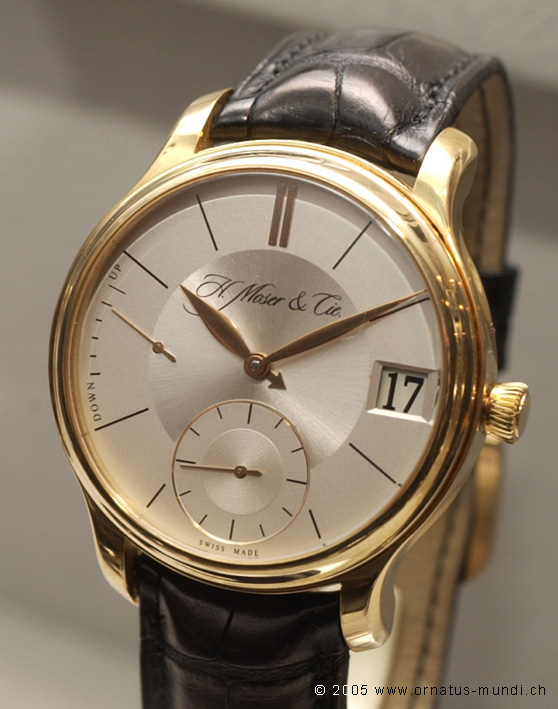
Perpetual by H. Moser, showing (big) date and month, via the rudimentary hand in the center, pointing towards one of the twelve hour markers, substituting the months. The leap year indication is on the rear.
5. Secular calendars take this over the top, by even knowing this 100 years rule, and are independent from user interference for 400 years even, when the calendar arithmetics enforces an exception from the 100 years rule (happened in 2000, luckily for most owners of perpetual calendars). The only wristwatch featuring a secular calendar, at least the only one I know about, is made by Svend Andersen:
6. Astronomical calendars: A very special breed of calendar watches are those that connect the passage of the days and months to the astronomical movement of Earth, moon, the planets and/or the stars. Here, the main problem is that the movements of the celestial bodies do not observe our civil calendar's strict division into 24 hours intervals. For an astronomical watch, a year does not pass in exactly 365 days, with an additional day every four years, but in roughly 365.25 days, needing about a quarter of a day longer than a standard calendar watch. Therefore, the display of a date is either completely omitted, or needs a highly complex mechanism, to "translate" the astronomically correct display into the incorrect - but common - date indication.

Ref. 5002, Sky Moon, by Patek Philippe: one of, if not THE the most complex calendar wristwatch ever built

Astrolabium, by Ulysse Nardin: Astronomical wristwatch, indicating the weekday and the month
The useability issue: Setting a perpetual calendar watch
Unfortunately, the theoretical accuracy of the calendar mechanism has not much to do with the physical reality: Whenever a watch is stopped for a time, all indications have to be newly set. It is then a question of the individual mechanism's ergonomics and usability whether this procedure is simple or complicated, or can even damage the delicate mechanism when something is done wrongly.
The majority of perpetual calendars, regardless of the number of their indications, offer a correction pusher for every indication. Thus, the owner can "compose" every possible date, including the moon phase. This enables him to keep his watch in hand, even in those infamous "exception years" mentioned above, making the necessary adjustments himself. The problem is that in most cases, you simply cannot stampede towards the pushers however you like, pressing them in arbitrary sequence; one has to follow a very precise procedure, and otherwise risks a costly repair.
Therefore, some manufacturers produced a more "foolproof" system, by firmly coupling all indications together. This means that the watch knows which weekday is the 5th of March 2012, and which phase of the moon this day has. All the user has to do, when the watch has stopped for a while, is adjusting the indications forward until the correct date is shown. This system's disadvantage lies in its rigidness: If the owner, full of enthusiasm and energy, "overshoots" the current date, his only option is to leave his watch inactive, until the desired day has come (I call this the "Sleeping Beauty-problem"), or to send the watch to the manufacturer, asking to adjust it to the correct date, which is of course a costly solution. Also, these watches have to be sent for adjustment every 100 years to correct the mechanism in the exception years.
IWC's Da Vinci is a prominent example of this system:
A few manufacturers opted for a system that permits a simple adjustment by the owner, by decoupling only one indication, mostly that of the weekday. Setting the weekday independently is somehow a compromise between the "adjust every single indication" approach and the foolproof full program. This system permits a flexible and relatively simple adjustment by the user, while keeping the mechanism user-friendly and solid.
Copyright October 2010 - Marcus Hanke & PuristSPro.com - all rights reserved
Comments:

watchme October 7th, 2010-10:17
Nice write-up, Marcus... Breitling still uses the "Caliber 19" in their "Olympus" and Bentley Mark VI Cal 19 models. The Olympus was previously the 1461 (to correspond with the number of days). This module from Dubois Dupraz is one of the only semi-perpetual calendars I know and ...

Marcus Hanke October 8th, 2010-06:51
I hoped to find a nice picture of the Breitling I could use ... ... but all those I found were either too small, too protected or too unsharp. The Breitling is a great watch, I always admired it. However, I would have difficulties reading the small indications today. Regards, Marcus

cazalea October 7th, 2010-13:08
Fantastic summary! Marcus, Thank you very much for the clear indication of the issues, terms and technologies used in these watches. I especially liked the distinction you made between (a) the complexity of the date-calculating movement and (b) the complexity of the dial in...

Marcus Hanke October 11th, 2010-07:26
Your GST perpetual ... ... always was one of my favourites, being among the very small group of sportive perpetuals. Unfortunately, your titanium version is practically impossible to find, while in steel, it is a bit easier, especially the somewhat unique salmon-dial version. F...

dsgalaxy1 October 7th, 2010-14:23
I think... that the state of the art for a perpetual calendar is with instantaneous changes of date display.

Marcus Hanke October 11th, 2010-07:29
The instantaneous change is a matter of clever energy management ... ... but has nothing to do with the calendar mechanism. For me, it is more important that a perpetual can be set forward and back ward without damaging the mechanism, but I agree with you that for using the calendar, an instantaneous change of all indicati...

dsgalaxy1 October 11th, 2010-11:39
Chopard is semi instantaneous for what I have read

Marcus Hanke October 11th, 2010-23:36
Maybe my memory is cheating me .... ... but I recall having seen all indications jumping at once, when the watch was demonstrated to me. The Moser is instantaneous, but has only two indications (date and month), compared to the the up to five indications of other perpetuals. Regards, Marcus

jporos October 7th, 2010-20:27
Thank you Marcus... for an illuminating post. The diagrams showing how the date and day/date mechanisms work were most interesting. I wonder if there are similar diagrams for the perpetual calendar movement? Thanks again.

Marcus Hanke October 11th, 2010-07:30
Unfortunately, I have no diagrams at hand .... ... but I will try to make some as soon as I can. Regards, Marcus
0-10-10
Load More Comments
Next Article
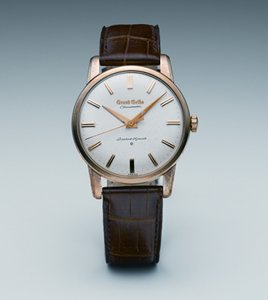
SJX


Grand news - Grand Seiko to be launched worldwide in October and new English GS website
SJX


News of the worldwide launch of Grand Seiko first surfaced at Baselworld 2010. Seiko has just announced that the watches will be launched worldwide later this month, as well as the launch of a brand new English language website dedicated to Grand Seiko at http://www.grand-seiko.com . - SJX Press release: New to the international market, but with half a century of successful history in Japan, Grand Seiko is to be launched worldwide in October, 2010. At Baselworld, 2010, SEIKO WATCH CORPORATION announced its intention to make Grand Seiko available to the world market.
© 2017 - WatchProZine

